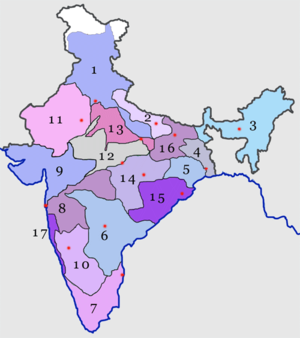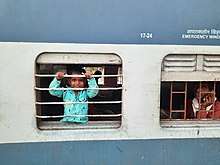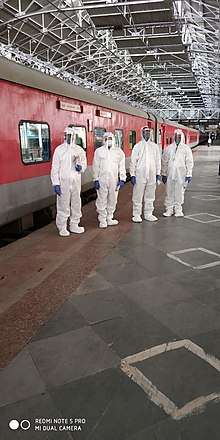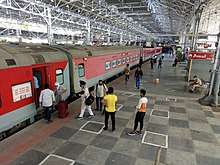Western Railway zone
The Western Railway (abbreviated WR) is one of the 18 zones of Indian Railways, and is among the busiest railway networks in India. The major railway routes of Indian Railways which come under Western Railways are: Mumbai Central - Ratlam, Mumbai Central - Ahmedabad and Palanpur - Ahmedabad. The railway system is divided into six operating divisions: Ahmedabad, Vadodara, Rajkot, Bhavnagar, Ratlam, and Mumbai WR. Vadodara railway station, being the junction point for the Ahmedabad - Mumbai route and the Mumbai - Ratlam route towards New Delhi, is the busiest junction station in Western Railways and one of the busiest junctions of Indian Railways too, while Ahmedabad Division earns highest revenue followed by Mumbai Division and Vadodara Division. Surat railway station is one of the busiest railway station in Western Railway in non-junction category where more than 160 trains pass per day.[1][2]
 | |
 Western Railway System Map-9 | |
| Overview | |
|---|---|
| Headquarters | Churchgate, Mumbai, Maharashtra, India |
| Reporting mark | WR |
| Locale | Maharashtra, Gujarat, Rajasthan, Madhya Pradesh |
| Dates of operation | 5 November 1951–present |
| Predecessor |
|
| Technical | |
| Track gauge | Broad Gauge, Metre Gauge & Narrow Gauge |
| Other | |
| Website | WR official website |

Western Railway General Manager's official bungalow 'Bombarci' (abbreviation of Bombay, Baroda and Central India) is located on Altamont road in Cumbala hill, Mumbai.[3]
History
The Western Railway was created on 5 November 1951 by the merger of several state-owned railways, including the Bombay, Baroda, and Central India Railway (BB&CI), and the Saurashtra Railway, Rajputana Railway and Jaipur State Railway. The narrow gauge lines of Cutch State Railway was also merged into it in 1951.
The BB&CI Railway was itself inaugurated in 1855, starting with the construction of a 29-mile (47-km) broad gauge track from Ankleshwar to Utran in Gujarat state on the west coast. In 1864, the railway was extended to Mumbai.
Subsequently, the project was further extended beyond Vadodara in a north easterly direction towards Godhra, Ratlam, Nagda and thereafter northwards towards Kota and Mathura, to eventually link with the Great Indian Peninsular Railway, now the Central Railway, which had already started operating in Mumbai in 1853. In 1860 Surat railway station was built and it was first railway station in Asia which is having platform on first floor (above ground level). In 1883, a metre gauge railway system, initially linking Delhi with Agra, Jaipur and Ajmer, was established.
The first suburban service in Mumbai with steam traction was introduced in April 1867. It was extended to Churchgate in 1870. By 1900 45 trains in each direction were carrying over one million passengers annually.
The railways of several princely states were also integrated into the Western Railway. The Gaekwars of Baroda built the Gaekwar's Baroda State Railway (GBSR), which was merged into the BB&CI in 1949. Several railways of western Gujarat, including the Bhavnagar, Kathiawar, Jamnagar & Dwarka, Gondal, and Morvi railways were merged into the Saurashtra Railway in 1948. The Jodhpur–Bikaner Railway was taken over by Rajasthan state in 1949, after the western portion was ceded to the government of Pakistan.[4]
In 2002, the Jaipur and Ajmer divisions of the Western Railway became part of the newly created North Western Railway, and in April 2003 the Kota division of the Western Railway became part of the newly created West Central Railway.
Present

Western Railway headquarters is in Mumbai's Churchgate station and serves the entire state of Gujarat, some portions of Western Madhya Pradesh, and coastal Maharashtra. The Western coast of India served by Western Railway has a number of ports, most important among them being Kandla, Hajira, Surat, Dahej, Mundra, Okha, Veraval, Porbandar, Bhavnagar in Gujarat state and Mumbai in Maharashtra.
Navapur railway station is unique as it falls in both the state's of Gujarat and Maharashtra because both were as a one state of Bombay State before 1960 and after States Reorganization Act the Navapur station was divided equally among Gujarat and Maharashtra.[5] So is the Surat railway station unique. It is Asia's one of the first railway station where the platforms is on the first floor, that is above the ground level. The ticket counter is on the ground floor.[6]
Electric Multiple Units (EMUs) ply between Churchgate and Virar (60 km) and is projected to extend the service till Dahanu Road (Services actually started on 16 April 2013), while Mainline Electrical Multiple Units (MEMUs) service the section beyond Virar till Dahanu Road (60 km). EMUs are of 12 car or 15 car rakes and are differentiated as slow and fast locals. Slow trains halt at all stations, while fast ones halt at important stations only and are preferable over longer distances. The first electric train on this section was introduced in 1928 between Churchgate and Andheri.
Western Railway Operations during COVID-19 and Lockdown

Due to ongoing lockdown in India and subsequent suspension of regular train services, Indian Railways has started Shramik Special Trains from various parts of India to carry migrant laborers stranded in various cities. Western Railway also started its Shramik Special operations on 02, May 2020. Trains are being run by WR from various cities on its jurisdiction to states of Uttar Pradesh, Bihar, Jharkhand, West Bengal, Orissa, Rajasthan & Madhya Pradesh. By 31 July 2020, WR has run around 1234 Shramik Special Trains carrying more than 18.5 lakh migrants to their home states. WR is following all social distancing norms and running these trains as per the request from the state governments.

Indian Railways is also running parcel trains and goods trains with increased efficiency so as to transport essential items across the country. Railways has ensured that the supply chain is maintained and there is no scarcity of essential items and medicines in the country.
From 12th May Indian Railways also started a limited number of passenger services of which 2 were from Western Railway. Further from 1 June 2020, 17 more services were introduced on WR as special trains. The regular train operations have still not begun. On arrival at the destination, the passenger has to follow all COVID safety norms made applicable by the respective states. WR carries out thermal checking if the passengers before boarding and the passengers have to report 90min before the departure of the train. The onboard ticket checking staff has been provided PPE kits.



Western Railway COVID warriors- all front line staff are braving the risk and running the services to ensure that the supplies are maintained and the needy reach their homes.
Heritage Gallery, Mumbai
Conserving heritage, Western Railway has opened Heritage Gallery at its headquarters building at Churchgate, Mumbai. The Gallery has recently been renovated. It is a collection of various models of BB&CI era, the precursor of Western Railway. Many notes of agents of BB&CI dating back to 1860s have also been displayed. Suburban timetable of 1948, steam engine model, signalling equipment, Model of 1928 EMUs, working model of Auxiliary Warning System, etc. have been beautifully displayed.
 A view of Heritage Gallery, at Western Railway Headquarters, Churchgate, Mumbai
A view of Heritage Gallery, at Western Railway Headquarters, Churchgate, Mumbai Heritage Gallery of Western Railway at Churchgate, Mumbai
Heritage Gallery of Western Railway at Churchgate, Mumbai Artifacts displayed in the gallery
Artifacts displayed in the gallery Model of Steam Engine on Display
Model of Steam Engine on Display
The gallery gives an insight about the development of lines on Western Region of India. The BB&CI map dating back to 1930s shows us that the Western line started from Mumbai via Vadodara, Ratlam connected GIP Railway at Mathura to reach Delhi and further Peshawar. The Frontier Mail (Golden Temple Mail) used to once run up to Peshawar. The Gallery is open for public free of cost during working hours and on special occasions.[7]
Steam Roller conserved and put on display
A steam roller of 1948 used by Railways to construct roads alongside tracks has been conserved by Western Railway and put on display at Bandra Terminus. This is one of the first steam rollers manufactured by Tatas for Western Railway. It was last used until 20 years ago after which it was lying unused in railway yard in Valsad. This 10 tonne machine has been transported to Mumbai and repaired and beautified using sand blasting technique.[8]
 Steam Roller on display at Bandra Terminus
Steam Roller on display at Bandra Terminus Steam Roller conserved and put on display at Bandra Terminus, Mumbai
Steam Roller conserved and put on display at Bandra Terminus, Mumbai.jpg) Steam Roller on display at Bandra Terminus, Mumbai
Steam Roller on display at Bandra Terminus, Mumbai
Major Routes
- New Delhi–Mumbai main line
- Ahmedabad–Mumbai main line
- Jaipur–Ahmedabad line
- Udhna–Jalgaon line
- Gandhidham–Ahmedabad main line
- Viramgam-Okha line
- Surendranagar–Bhavnagar line
- Jamnagar–Porbandar line
- Rajkot–Somnath line
- Gandhidham–Palanpur section
- Gandhidham–Bhuj section
- Gandhidham–Kandla Port section
- Gandhidham–Samakhiali section
- Porbandar–Jetalsar section
- Maliya Miyana–Wankaner section
- Rajkot–Wankaner section
- Viramgam–Mahesana section
- Viramgam–Maliya Miyana section
- Viramgam–Surendra Nagar section
- Wankaner–Surendra Nagar section
- Dharangadhra–Surendra Nagar section
- Mahesana–Bhildi section
Major Stations
- Ahmedabad Junction
- Amalner
- Anand Junction
- Andheri
- Ankleshwar Junction
- Badnagar
- Bandra Terminus
- Bharuch Junction
- Bhavnagar Terminus
- Bhildi Junction
- Bhuj
- Bilimora Junction
- Boisar
- Borivali
- Botad Junction
- Chhayapuri
- Chittaurgarh Junction
- Churchgate
- Dabhoi Junction
- Dadar Western
- Dahanu Road
- Dahod
- Dewas Junction
- Dhola Junction
- Dhrangadhra Junction
- Dondaicha
- Dr. Ambedkar Nagar (Mhow)
- Fatehabad Chandrawatiganj Junction
- Gandhidham Junction
- Gandhinagar Capital
- Godhra Junction
- Goregaon
- Hapa
- Indore Junction
- Jamnagar
- Jaora
- Jetalsar Junction
- Junagadh Junction
- Kalol Junction
- Mahesana Junction
- Mahuva Junction
- Maliya Miyana Junction
- Mandsaur
- Meghnagar
- Morbi
- Mumbai Central
- Nadiad Junction
- Nagda Junction
- Nandurbar
- Navapur
- Navsari
- Neemuch
- Okha
- Palanpur Junction
- Palghar
- Palitana
- Patan
- Porbandar
- Rajkot Junction
- Ratlam Junction
- Saphale
- Siddhpur
- Sihor Junction
- Somnath
- Surat
- Surendranagar Junction
- Udhna Junction
- Ujjain Junction
- Unjha
- Vadodara Junction
- Valsad
- Vapi
- Vasai Road
- Veraval Junction
- Viramgam Junction
- Virar
- Vyara
- Wankaner Junction
See also
- Zones and divisions of Indian Railways
- All India Station Masters' Association (AISMA)
References
- "About Western Railway". Total Train Info.
- "Railway Zones and Divisions". Press Information Bureau, Government of India.
- "HERITAGE INVENTORY OF INDIAN RAILWAYS:BUILDINGS AND STATIONS" (PDF). Indian Railways.
- "History of Western Railway". Western Railway.
- "इस रेलवे स्टेशन पर टिकट कटता है महाराष्ट्र में तो ट्रेन रुकती है गुजरात में". Bhaskar.
- "Surat Railway: Western Railway Zone". Irctc News.
- "Churchgate Heritage Gallery". Museums of India.
- "WR restoring 66-yr-old steamroller, to display it at Bandra Terminus". Mumbai Mirror.